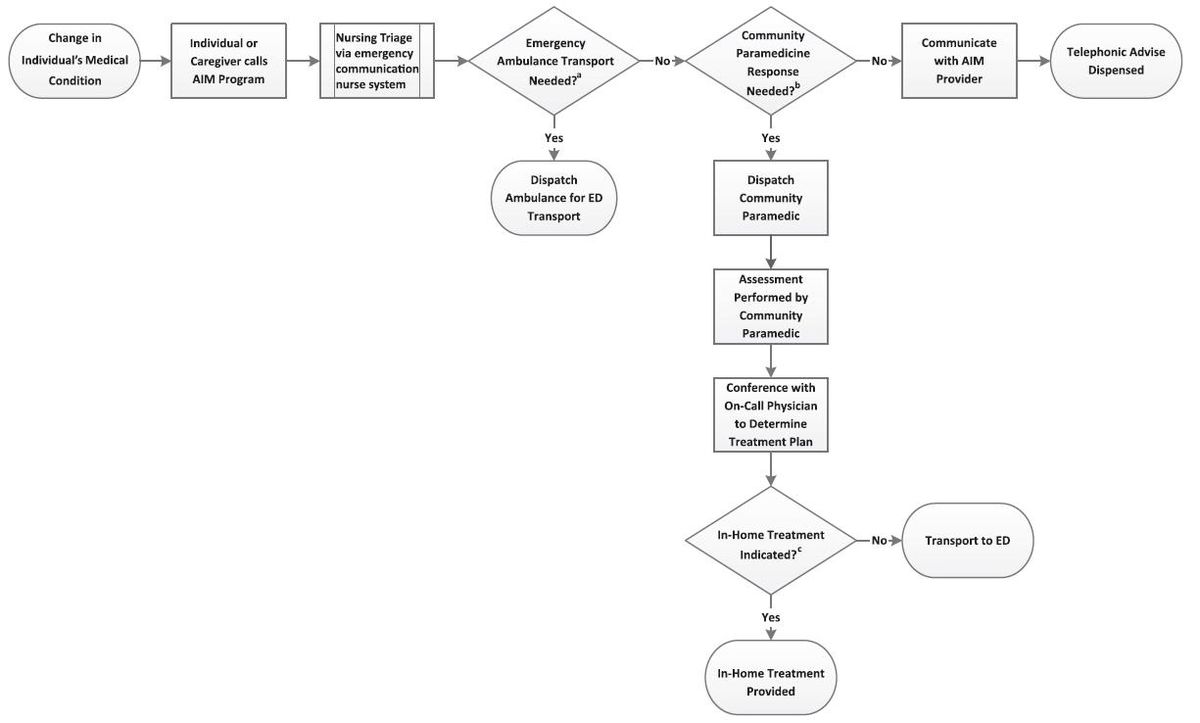Northwell Health (N.Y.) has published preliminary results of the impact their community paramedicine program had within an advanced illness management program. “Providing Acute Care at Home: Community Paramedics Enhance an Advanced Illness Management Program — Preliminary Data” was published in the Journal of American Geriatric Society on August 30, 2016.
Of the 1,602 patients enrolled in advanced illness management, see the workflow diagram, over the first 16 months, just under 50 percent required an emergency response. Of those “404 patients used community paramedicine at least once, and 369 patients used only traditional EMS.”
There were a total of 1,755 responses for the 773 patients, of which nearly 38 percent were community paramedicine responses. Patients that were seen by the community paramedics remained at home 78 percent of the time and only nine those patients were subsequently transported to the emergency department within 24 hours of the community paramedic visit.
When patients that were initially seen by community paramedics required treatment at the ED, their chance of being admitted to the hospital was significantly higher than those transported via traditional EMS, however there was no difference in the length of stay between the two groups.
Community paramedics were utilized for respiratory complaints in 23.6 percent of responses, neurological and psychiatric issues were 17.9 percent of responses, generalized discomfort or weakness was seen 15.2 percent of the time and cardiac or blood pressure concerns were addressed in 10.1 percent of the responses.
One hundred and sixteen patients and caregivers completed a survey on their experiences. All felt that community paramedicine delivered a high-quality service, almost all agreed that they would use the service again, and just over 90 percent admitted that they would have pursued traditional emergency care had the community paramedicine program been unavailable.
Memorable quotes:
Here are four memorable quotes from the article about the Northwell Health community paramedicine (CP) program:
- “This program is designed to honor individuals’ goals of care.”
- “Preventing even a few admissions could offset the cost of a CP program and generate revenue in risk-based arrangements.”
- “The significantly higher admission rate for individuals transported by CP shows that paramedic-physician teams can identify the sickest individuals who need and want inpatient treatment.”
- “This report shows the potential feasibility and benefits of a CP model in which paramedics and physicians move from risk-avoidant towards risk-tolerant care and supports the model’s further evaluation.”
Key takeaways on the Northwell Health preliminary data
Here are the key takeaways for EMS leaders and community paramedics.
1. Significance of peer review
This is one of the first peer-reviewed publications based within the U.S. to show that community paramedicine programs can be effective. Although a number of community paramedicine programs openly publicize their results on the internet and at EMS trade shows, the decision by the authors to seek out peer review is significant for the advancement of the science of EMS.
2. Build awareness of EMS
The authors’ decision to publish in a non-EMS specific journal is also significant. It means that providers and researchers with no prior exposure to the utility of EMS are reading about it.
3. Observational study
This study was a prospective observational study, meaning there was no true control group. The results can only be taken at face value in the context of Northwell Health, an organization that has openly demonstrated high-institutional support for such a novel care delivery model.
Other EMS organizations hoping to duplicate the success seen here must recognize there are a variety of factors to be considered before starting such a program.
What are your top takeaways after reading the research on the Northwell Health community paramedic program?
 Workflow diagram for the Northwell Health advanced illness management program that included a community paramedicine response component.
Workflow diagram for the Northwell Health advanced illness management program that included a community paramedicine response component.












